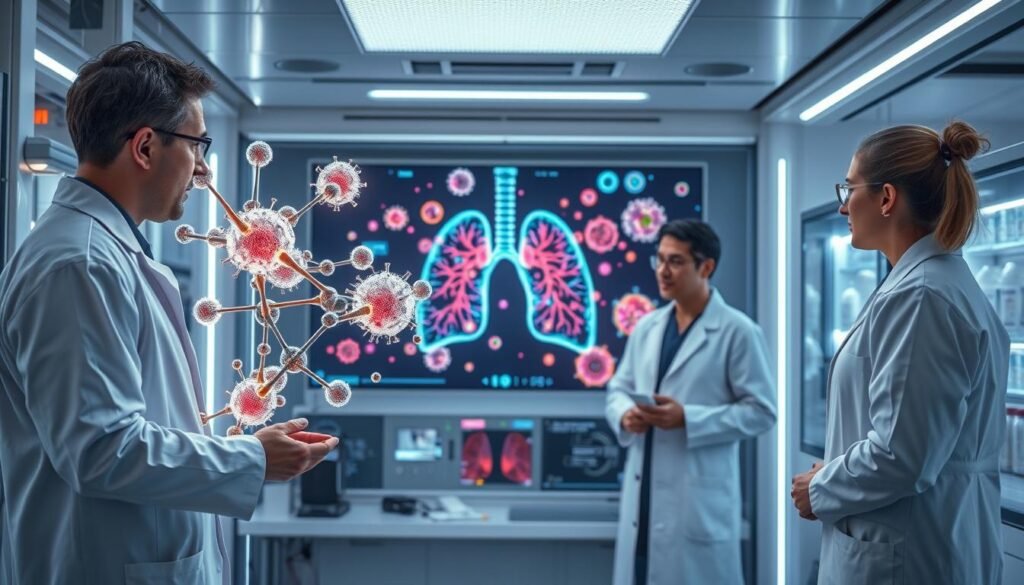Machine learning algorithms now diagnose lung cancer types with 97% accuracy. This shows the power of technology in health care, especially in innovations in lung cancer research and treatment. These breakthroughs are changing the way we find and treat lung cancer.
Early lung cancer detection is key to better patient outcomes. Advances in personalized therapies are leading the charge. They use genomic insights to create treatments for individual patients. This could lead to higher survival rates. New screening methods are also helping find the disease earlier, giving hope to many.
In this article, we’ll look at the newest innovations in lung cancer treatment. These advancements promise a better future for those impacted by the disease.
Key Takeaways
- Machine learning can diagnose lung cancer types with 97% accuracy.
- Early detection significantly enhances treatment outcomes.
- Personalized therapies are transforming patient care.
- CT scans are pivotal for high-risk populations.
- Innovations in treatment strategies are increasing survival rates.
Understanding Lung Cancer: A Brief Overview
Lung cancer is a serious health issue and is the third most common cancer in the nation. It mainly comes in two types: non-small cell lung cancer (NSCLC) and small cell lung cancer (SCLC). About 85% to 90% of lung cancer cases are NSCLC, while SCLC makes up 10% to 15%.
NSCLC includes different subtypes, with adenocarcinoma being the top one. In stage 1 NSCLC, the tumor is up to 5 cm wide and hasn’t spread. This makes it possible to remove it. On the other hand, SCLC grows and spreads faster. In its limited stage, it stays in one lung and may reach nearby lymph nodes.
It’s crucial to know what causes lung cancer to prevent it and catch it early. Smoking leads to up to 90% of lung cancers. Nearly 60% of cases are in those who used to smoke. Secondhand smoke exposure also causes many new cases every year.
The right treatment depends on the cancer’s stage, which means how big the tumor is and if it has spread. Stage 4 lung cancer means it has spread elsewhere and isn’t curable. But treatment can still help extend life and improve quality of life.
Each year, the U.S. sees about 235,000 new lung cancer cases. It’s important to recognize symptoms like constant coughing, chest pain, and weight loss. The understanding of lung cancer helps greatly in preventing and treating it.
The Importance of Early Detection in Lung Cancer
Early detection is key in fighting lung cancer. In the U.S., lung cancer ranks second in diagnoses and is the top cause of cancer deaths. The American Cancer Society says finding lung cancer early can greatly improve survival chances, jumping from 28% to 65%. That’s why screenings are crucial, especially for those at high risk.
People who have smoked a lot over the years, aged 50 to 80, should look into early lung cancer screening with LDCT scans. Research, like the National Lung Screening Trial, shows LDCT scans can cut lung cancer death rates by 20% compared to regular chest x-rays.
About 85% of lung cancer cases are found late, making treatment harder. LDCT scans are good not just for spotting lung cancer. They can also find other issues that need checking. So, it’s vital to get scanned at places with the right tech and experts.
- Lung cancer screening is covered by Medicare and many private insurance plans.
- Quitting smoking advice is key for those at higher risk.
- Screenings are helpful for those who can get treatment if needed.
Not enough people know they should get screened for lung cancer. Spotting early signs can mix up with signs of COPD, a lung disease. This makes fast action and medical advice crucial. For more info on spotting these diseases, check out this link.
Pushing for more screenings and early detection can save lives. By being proactive, people greatly improve their chances of beating lung cancer early. This leads to better chances of survival and health.
Innovations in Lung Cancer Research and Treatment
Recent breakthroughs have changed the fight against lung cancer. The focus now includes lung cancer biomarkers for personalized care. These biomarkers let doctors customize treatment based on a tumor’s unique genes. This means better outcomes from treatments.
Advancements in Biomarker Testing for Personalized Therapies
Biomarker testing is key in combating lung cancer. New biomarkers are constantly found, improving our knowledge of the disease. Techniques like liquid biopsies are notable. They find genetic changes in blood, aiding early detection and tailored therapies.
Machine learning also boosts lung cancer research. It helps doctors quickly sift through data for better patient care. With it, treatments can be more precisely matched to a patient’s cancer type.
Screening Techniques: CT Scans and Beyond
Early detection through screening is vital. Low-dose CT scans are a major tool, spotting early cancers. Those over 55 who smoked a lot should get yearly scans. This advice is from leading health sources like the Mayo Clinic.
Research on new screening methods is underway. Few eligible Americans get screened today. Increasing awareness might boost screening numbers. This could lead to earlier detection and better outcomes for lung cancer patients.
The progress in lung cancer research is inspiring hope. These innovations point to more successful, personal treatments. For more on lung cancer biomarkers and research, visit this resource.
Targeted Therapies: A New Age of Treatment
New treatments for lung cancer, especially non-small cell lung cancer (NSCLC), are changing the game. About 85% of all lung cancers are NSCLC. The big game changers are ALK and EGFR inhibitors. These treatments are effective in clinical trials. They target specific gene mutations, offering better options for patients.
ALK and EGFR Inhibitors: Pioneering Treatment Approaches
ALK inhibitors, like alectinib, are now key for treating NSCLC with ALK gene changes. EGFR inhibitors, such as osimertinib, have also greatly improved survival for those with EGFR mutations. These treatments are approved by the FDA. They show the value of targeted lung cancer therapies. They allow for customized treatments based on a patient’s genetics. These options are much more effective than old-school chemotherapy.
Emerging Therapies for KRAS Mutations
There are new treatments for lung cancer with KRAS mutations showing promise. KRAS mutations used to be hard to treat. But now, new drugs are being made for these specific mutations. This marks a shift towards more personalized medicine. Targeted therapies are improving patient outcomes. They also open the door for new treatments for other tough cancers.

| Mutations | Targeted Therapies | Key Drugs | Advantages |
|---|---|---|---|
| ALK | ALK Inhibitors | Alectinib | High response rates in ALK-positive patients |
| EGFR | EGFR Inhibitors | Osimertinib | Improved survival and control over disease |
| KRAS | Emerging Therapies | Targeted KRAS inhibitors | Hope for previously difficult-to-treat mutations |
Immunotherapy: Transforming Lung Cancer Treatment
Immunotherapy for lung cancer has brought new hope to patients. It uses the body’s own defense system to fight cancer. Checkpoint inhibitors help the immune system find and destroy cancer cells better. This approach is changing lung cancer care for the better.
Checkpoint Inhibitors and Their Role in Treatment
Nivolumab and pembrolizumab are key players in lung cancer therapy. Nivolumab works well in treating squamous cell lung cancer. It has shown promising results and got approved recently. Pembrolizumab also shows promise in treating non-small cell lung cancer and has earned FDA recognition.
These drugs, targeting PD-1/PD-L1, are well-tolerated and help about 20% of patients. They offer responses lasting about 18 months. Non-small cell lung cancer, which shows PD-L1 presence in many cases, is a good target for these therapies.
Research is exploring how to combine nivolumab and pembrolizumab with other treatments. This work aims to find better ways to treat different lung cancers. Studies show varied success rates, highlighting the need for tailored treatment plans.
Immunotherapy offers hope to those fighting lung cancer. It’s a promising path forward in battling this tough disease. For more details on these treatments and current studies, visit this resource.

Clinical Trials: Paving the Way for Future Treatments
Clinical trials are crucial for developing new lung cancer treatments. They test new therapies and explore how the disease works. Most research has been on non-small cell lung cancer (NSCLC). This type makes up the majority of lung cancer cases. Centers like Lindus Health play a vital role in this research.
Insights from Recent Trials on Targeted Therapies
Recent trials have made great strides in lung cancer research. They’ve introduced therapies like BBT-176, effective against certain mutations. Sotorasib is also showing promise for KRAS mutations, which have been hard to treat until now.
New kinds of treatments are on the rise. For example, antibody-drug conjugates like trastuzumab deruxtecan. They attack cancer in new ways. Advanced radiation methods, including IMRT and SBRT, have also improved care.
Getting enough people to join these trials is tough. But it’s crucial for gathering strong data. Organizations like Lindus Health are important. They make sure trials are well-run and give useful results.

Lung Cancer Genomics: The Future of Precision Medicine
Lung cancer genomics marks a big step in precision medicine in cancer treatment. It happens in a context where over 200,000 new cases occur yearly in the U.S. Understanding the genetics of lung tumors is key to creating effective treatments. Providers can use information about mutations in a tumor’s DNA to design tailored therapies.
About 45% of all lung cancers are lung adenocarcinomas. In 60-70% of these cases, actionable alterations are found. It’s noteworthy that lung cancer genomics shows that 25-30% of these have KRAS mutations. There are also ERBB2 mutations in about 3% and BRAF mutations in roughly 2%. This shows the diverse genetics involved, highlighting the need for personalized treatment.
The Lung Cancer Mutation Consortium found key alterations in 64% of lung adenocarcinomas tested. Patients with targeted therapies often have better survival rates than those without. This points us towards new ways to tackle lung cancer, focusing on the specific genetics of each case.
The table below shows key mutations found in lung adenocarcinomas. It underscores the importance of lung cancer genomics in clinical decision-making.
| Mutation | Prevalence (%) |
|---|---|
| KRAS | 25-30 |
| ERBB2 | 3 |
| BRAF | 2 |
| PIK3CA | 1 |
| MAP2K1 | 1 |
| NRAS | 1 |
| ROS1 and RET fusions | 1-2 |
It’s vital to keep exploring lung cancer genomics for better precision medicine. By thoroughly profiling a patient’s genetics, doctors can craft targeted treatments. This new approach is revolutionizing lung cancer care, promising better patient outcomes.
Lung Cancer Prevention Strategies for High-Risk Populations
Lung cancer prevention is key, especially for those at high risk like smokers or people with a family history. Knowing what increases your chance of lung cancer is the first step to prevent it.
Stopping smoking greatly lowers your chance of getting lung cancer. Those who quit can gradually heal their lungs. After 10 years without smoking, the risk can drop by 30-60%.
Radon is a big cause of lung cancer too. It’s important to test your home and reduce radon levels. Roughly 26% of lung cancers in non-smokers are because of radon. Fighting radon is as crucial as quitting smoking.
Eating lots of fruits and veggies can also help lower your lung cancer risk. The American Cancer Society suggests following nutritional advice and staying active. However, it’s tough to say how effective this is because of smoking’s effects.
Be careful with vitamin supplements though. High doses have not been shown to lower lung cancer risk. In fact, some supplements might increase the risk in smokers.
Research is ongoing to find more ways to prevent lung cancer. Clinical trials test lifestyle changes, drugs, and supplements. These trials help find new methods to reduce lung cancer risks in those most vulnerable.
| Prevention Strategy | Effectiveness | Notes |
|---|---|---|
| Smoking cessation programs | High | Reduces risk significantly |
| Radon testing and mitigation | Moderate to High | Essential for non-smokers |
| Healthy diet | Moderate | Rich in fruits and vegetables recommended |
| Vitamin E and beta-carotene supplements | Low | Not effective; may increase risk |
| Clinical trials on lifestyle changes | Variable | Under ongoing research |
Conclusion
The world of lung cancer treatment has changed a lot in the last ten years. Treatments like osimertinib are now leading the fight against non-small cell lung cancer (NSCLC). This marks a vital shift towards early diagnosis and treatment tailored to each patient, improving survival.
Although only 20% of lung cancer patients live more than five years after being diagnosed, there’s hope. New surgical techniques and targeted therapies are making a difference. They help patients live better and longer by tackling the disease’s challenges.
The outlook for lung cancer care is looking brighter. Thanks to research and new technology, we’re on the cusp of boosting survival rates and cutting down deaths from lung cancer. Better screening methods, like low-dose CT scans, could potentially save many lives. They might add up to 500,000 years of life for people at risk if more got screened.
Want to know more about the progress in treating lung cancer? Check out the latest findings here.